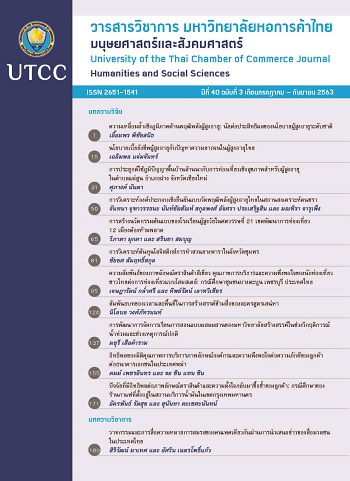Confirmatory Factor Analysis of Active Aging Scale for Thai People in a Nursing Home
Main Article Content
Abstract
The current study aims to analyze the structural factors of Active Aging Scale for Thai People (AAS-Thai) in a nursing home and to verify the consistency between the measurement model of AAS-Thai in a nursing home and empirical data. 200 participants were purposively selected. The instrument used was AAS-Thai consisting of seven components. The internal validity was 0.95. Data analysis was done using LISREL 8.72. The results of first order CFA showed that all indices meet the fit indices criteria (= 377.57,
/df = 0.89, p-value = 0.95, CFI = 1.00, GFI = 0.94, AGFI = 0.91, RMR = 0.03, SRMR = 0.03 and RMSEA = 0.00), factor loading ranged from 0.66 to 0.94, p = .01. The results of second order CFA also showed that all indices meet the fit indices criteria (
= 379.38,
/df = 0.89, p-value = 0.93, CFI = 1.00, GFI = 0.94, AGFI = 0.91, RMR = 0.03, SRMR = 0.03 and RMSEA = 0.00), factor loading ranged from 0.72 to 0.97, p = .01. The components with the factor loading ranging from highest to lowest included: being actively engaged with society, being self-reliant, growing spiritual wisdom, engaging in active learning, maintaining healthy lifestyle, building up financial security and strengthening family ties for being cared for in the late life. The empirical data revealed that AAS-Thai was apt to be used as a measurement of active aging of Thai elderly in a nursing home.
Article Details
ลิขสิทธิ์ของบทความ
ผลงานที่ได้รับการตีพิมพ์ถือเป็นลิขสิทธิ์ของมหาวิทยาลัยหอการค้าไทย ห้ามมิให้นำเนื้อหา ทัศนะ หรือข้อคิดเห็นใด ๆ ของผลงานไปทำซ้ำ ดัดแปลง หรือเผยแพร่ ไม่ว่าทั้งหมดหรือบางส่วนโดยไม่ได้รับอนุญาตเป็นลายลักษณ์อักษรจากมหาวิทยาลัยหอการค้าไทยก่อน
References
ธนัญพร พรมจันทร์. (2556). ภาวะซึมเศร้า ความว้าเหว่ และการเห็นคุณค่าในตนเองของผู้สูงอายุที่พักอาศัยในสถานสงเคราะห์คนชราบ้านบางแค และที่พักผู้สูงอายุของเอกชนในเขตกรุงเทพมหานคร (วิทยานิพนธ์ปริญญามหาบัณฑิต ไม่ได้ตีพิมพ์). จุฬาลงกรณ์มหาวิทยาลัย, กรุงเทพฯ.
พิทพิชัย หรรษอุดม. (2548). การดำรงชีวิตในผู้สูงอายุอย่างประสบความสำเร็จ. กรุงเทพฯ: มหาวิทยาลัยธรรมศาสตร์.
เพ็ญแข ประจนปัจจนึก. (2550). รายงานวิจัยฉบับสมบูรณ์เรื่องการจัดการศึกษาและการเรียนรู้ตลอดชีวิตเพื่อเตรียมความพร้อมในการพัฒนาภาวะพฤฒิพลังในผู้สูงอายุไทย. กรุงเทพฯ: สำนักงานกองทุนสนับสนุนการวิจัย.
ภัทรพรรณ ทำดี. (2560). ตัวตน สังคม วัฒนธรรม: เงื่อนไขสู่การสูงวัยอย่างมีศักยภาพของผู้สูงอายุในจังหวัดเชียงใหม่. วารสารสังคมศาสตร์, 47(2), 109-131.
มูลนิธิสถาบันวิจัยและพัฒนาผู้สูงอายุไทย. (2560). รายงานสถานการณ์ผู้สูงอายุไทย ประจำปี 2559. กรุงเทพฯ: ผู้แต่ง.
ระวี สัจจโสภณ. (2556). แนวคิดทางการศึกษาเพื่อการพัฒนาภาวะพฤฒิพลังในผู้สูงอายุ. วารสารเกษตรศาสตร์ (สังคม), 34(3), 471-490.
เล็ก สมบัติ, ศศิพัฒน์ ยอดเพชร, และธนิกานต์ ศักดาพร. (2554). รายงานการวิจัยฉบับสมบูรณ์เรื่องภาวะสูงวัยอย่างมีคุณประโยชน์กับการพัฒนาสังคมและเศรษฐกิจในประเทศไทย. กรุงเทพฯ: สำนักงานมาตรฐานการพัฒนาสังคมและความมั่นคงของมนุษย์.
วริศรา ใจเปี่ยม, ผ่องพรรณ เกิดพิทักษ์, และประสาร มาลากุล ณ อยุธยา. (2558). รูปแบบการให้การปรึกษากลุ่มแบบบูรณาการเพื่อเสริมสร้างการเป็นผู้สูงอายุที่ประสบความสำเร็จ ในเขตกรุงเทพมหานครและปริมณฑล. วารสารพยาบาลทหารบก, 16(1), 51-61.
สมใจ โชติพันธุ์. (2550). การศึกษาความสัมพันธ์ระหว่างการสนับสนุนทางสังคมกับภาวะซึมเศร้าของ ผู้สูงอายุในสถานสงเคราะห์ผู้สูงอายุบ้านบางแค (วิทยานิพนธ์ปริญญามหาบัณฑิต ไม่ได้ตีพิมพ์). มหาวิทยาลัยศรีนครินทรวิโรฒ, กรุงเทพฯ.
สำนักงานสถิติแห่งชาติ. (2557). รายงานผลเบื้องต้นการสำรวจประชากรสูงอายุในประเทศไทย. กรุงเทพฯ: ผู้แต่ง.
สุทธิชัย จิตะพันธุ์กุล. (2545). หลักสำคัญของเวชศาสตร์ผู้สูงอายุ. กรุงเทพฯ: โรงพิมพ์จุฬาลงกรณ์มหาวิทยาลัย.
สุทัสศรี สายรวมญาติ. (2553). อิทธิพลความเชื่อเรื่องกรรมที่มีต่อชีวิตของผู้สูงอายุ: ศึกษากรณีผู้สูงอายุในศูนย์พัฒนาการจัดสวัสดิการสังคมผู้สูงอายุบ้านบางแค (วิทยานิพนธ์ปริญญามหาบัณฑิต ไม่ได้ตีพิมพ์). จุฬาลงกรณ์มหาวิทยาลัย, กรุงเทพฯ.
สุภจักษ์ แสงประจักษ์สกุล. (2557). วุฒิวัยของผู้สูงอายุไทย. วารสารสังคมศาสตร์ มหาวิทยาลัยศรีนครินทรวิโรฒ, 17, 231-248.
Belanger, E., Ahmed, T., Filiarault, J., Yu, H., & Zunzunegui, M. (2015). An empirical comparison of different models of active aging in Canada: The international mobility in aging study. The Gerontologist, 57(2), 197-205.
Comrey, A. L., & Lee, H. B. (2016). A first course in factor analysis (2nded.), New York, NY: Psychology Press.
Fernandez-Ballestereros, R., Robine, J. M., Walker, A., & Kalache, A. (2013). Active aging: A global goal. Current Gerontology and Geriatrics Research. doi:10.1155/2013/298012
Flood, M. (2002). Successful aging: A concept analysis. Journal of Theory Construction and Testing, 6(2), 105-108.
Hair, J. F., Black, W. C., Babin, B. J., & Anderson, R. E. (2010). Multivariate data analysis.(7thed.). Upper saddle River, NJ: Pearson Education International.
Schumacker, R. E., & Lomax, R. G. (2010). A beginner’s guide to structural equation modeling. New York, NY: Routledge.
Tabachnick, B. G., & Fidell, L. S. (2007). Using multivariate statistics. Boston, MA: Pearson Education.
Thanakwang, K. (2013). Development and psychometric testing of the active aging scale for Thai people (AAS-Thai) (Unpublished doctoral dissertation). Prince of Songkla University.
Thanakwang, K., & Soonthorndhada, K. (2006). Attributes of active aging among older persons in Thailand: Evidence from the 2002 survey. Asia-Pacific Population Journal, 21(3), 113-135.
Troutman, M., Nies, M. A., Small, S., & Bates, S. (2011). The development and testing of an instrument to measure successful aging. Research in Gerontological Nursing, 4(3), 221-232.
World Health Organization. (2002). Active ageing: a policy framework. Geneva, Switzerland: Author.
Yoon, E., & Kolomer, S. R. (2007). Refining the measure and dimensions of social values of older people. Educational Gerontology, 33, 649-669.
Zisberg, A., Young, H. M., & Schepp, K. (2009). Development and psychometric testing of the scale of older adults’ routine. Journal of Advanced Nursing, 65(3), 672-683.


